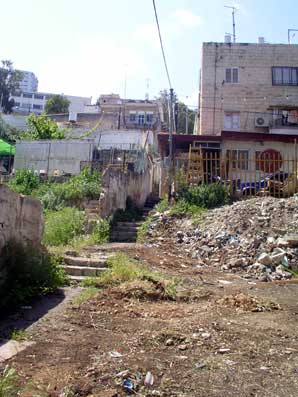 Short History
Short HistoryHallisa neighborhood was built in the 30’s and 40’s of the previous century on the steep slopes of Mount Carmel, in the eastern entrance to Haifa. Its original Arab population was forced to leave in the 1948 war, and the state institutes took control of most houses and lands in the neighborhood. Jewish immigrants were brought to live in the neighborhood. Due to years of neglect the neighborhood became the poorest in Haifa. Through the 70’s and 80’s another Arab community, most of them also refugees from 1948, bought the right to live as protected tenants in the state-held houses. Today about 70% of Hallisa’s 3,000 residents are Arab, and 30% Jews from different origins, including many new immigrants from the defunct Soviet Union and from Ethiopia.
The Socio-Economic Situation
Hallisa is well known as the poorest neighborhood in Haifa. Most of the residents work in manual unskilled jobs, and unemployment and under-employment is very high. For many years Hallisa was known for its free for all drug-trade, which ruined many youth. Until 10 years ago education was in constant decline, and it reached a point where in some years none of Hallisa’s pupils graduated high school.
For many years the authorities treated Hallisa as a burden on the city. Houses were left to decay, and no investment was made in infrastructure or services. This changed to some extent with the introduction of a ‘neighborhood reconstruction’ plan in 1994, but the neighborhood is still well behind the rest of the city.
Hardship and Struggle
Hallisa residents, and especially the local Arab community, have a long history of struggle for a better life. The biggest struggle was in the late 80’s – a popular insurrection against drug dealers, which succeeded to put an end to the neighborhood’s disastrous fame as a drug’s haven. Many other struggles were held to force the local authorities to give basic rights and services to Hallisa. There is also a long tradition of volunteer work for the improvement of the neighborhood.
In order to improve the social conditions, some local residents established the ‘Hallisa Development Association’ which opened a club and a kindergarten (see attached document). The latest famous Hallisa struggle was held against the municipality’s plan to widen local streets at the expense of the resident’s rooms, balconies, wards and small gardens. It culminated in January-February 2005, in 10 days of a ‘protest tent’ against the planned demolition of balconies. In the best of Hallisa tradition, it showed local unity, Arab and Jewish local residents spending together 24 hours a day in the tent, and it gained wide support from the Haifa civil society and beyond.
The Proposed City Plan
In the framework of the reconstruction project, the Haifa municipality prepared a ‘city building plan’ for Hallisa. In 2001, the plan was placed for approval in the interior ministry’s ‘District committee for planning and building’. As the Hallisa residents saw the plan, they found it to be a dangerous blow to their already hard life.
The plan’s main goal is to maximize building rights for entrepreneurs, while allowing living conditions to deteriorate. All local roads are to be expanded at the expense of the living space of local residents. The insufficient green areas will become even scarcer with the doubling of the population. The residents also warned that, as a result of lower mortgages given to Arab youth couples, most of the local youth will not be able to buy apartments in the new houses. As a result, there is a danger of social tension between the (also poor) inhabitants of the new houses and frustrated local people that will see their conditions deteriorating in the decaying old houses in an overcrowded neighborhood.
After legal and social struggle, the proposed plan was halted and the Haifa Municipality agreed on a process of citizens’ participation in order to repair the plan. Now Hallisa people and the Haifa municipality face a new challenge: the need to cooperate in order to come out with an agreed plan for the advancement of neighborhood.